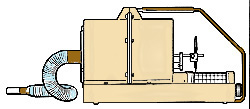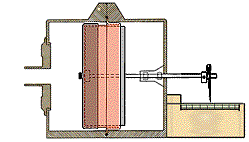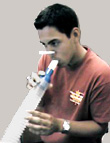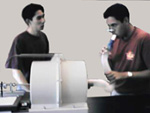|
Respiration
Laboratory |
The Spirometer |
| |
The Model 922 rolling dry-seal
spirometer is one of the many other models used for measurements of lung volumes versus time.
This spirometer uses a rolling seal design. A piston moves inside a
cylinder in response to a patient's breathing. The seal between the
piston and cylinder is an elastomeric seal which rolls, rather than
slides, as the piston moves within the cylinder. |
|
The rolling seal produces a linear
relationship between piston displacement and volume input. The piston is
supported by a rod that travels in precision bearings. Removal of air
from the bell causes the piston to move forward (thus inspiratory traces
"move" downward and expiratory traces upward). |
|

|
 |
|
The chart recorder has two paper speeds: 5
and 20 millimeters per second. The operator starts and stops the chart
drive with a hand switch. Lines on the chart paper are spaced to permit
time determination: one division every 2 seconds at 5 mm per second, and
2 divisions per second at 20 mm per second. The paper also has lines
spaced across the width at intervals equal to one liter of volume, ATPS
(Air Temperature Pressure Saturated) for each major division, with minor
divisions equal to 100 milliliters. The spirometer does not require a
correction factor to arrive at the proper volume; however you must
apply the BTPS correction factor for temperature differential. |
|
The following instructions must be followed
carefully in order to carry out the experiments successfully: |
 |
- The subject must wear a nose clip at
all times when performing the experiments.
- The subject should make certain a
fresh mouthpiece has been installed. The mouthpiece must be placed
inside the mouth so that only the tube part shows. If the mouthpiece
is merely "kissed", air leaks will result.
|
- The subject should not watch the
record while doing the experiment, and should also be "coached" and
encouraged by his/her partners, to ensure that maximum effort is
expended in performing the manoeuvre properly.
- The spirometer should be cleansed
after each manoeuvre by gently moving the piston back and forth, in
order to avoid CO2
buildup inside.
|
 |
|
To continue with the next section:
VC test, click here |